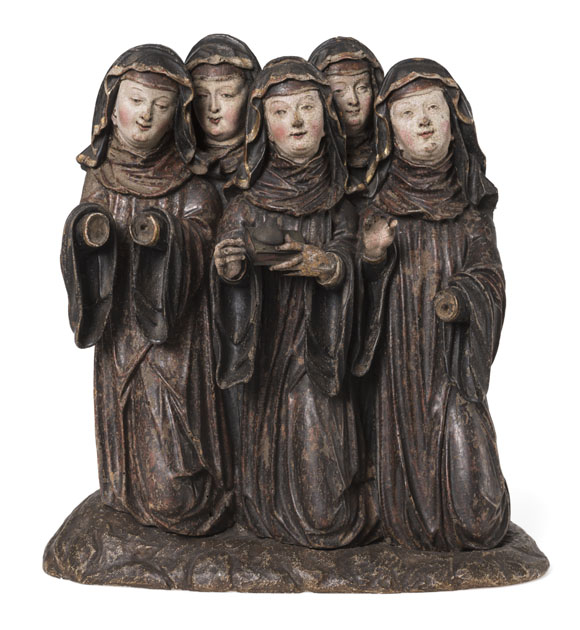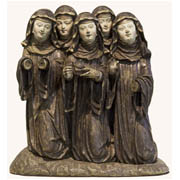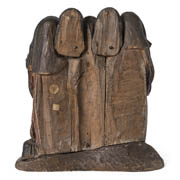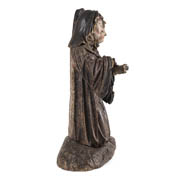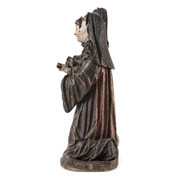Details
- Object type
wood carving
- Title
St Walburga and four nuns
- Artist/Maker
Martin Zürn possibly
- Place Associated
Germany, Swabia, Bad Waldsee, possibly (place of manufacture); Eichstätt (place associated)
- Date
circa 1600-1625
- Materials
limewood, paint, gilt
- Dimensions
overall: 444 mm x 355 mm 5420 g
- Description
-
Limewood sculpture of St Walburga and four companion nuns. All five figures are kneeling in prayer, wearing the habits and wimples of the Order of St Benedict. There are a number of losses, including, both hands of the nun to the left of the composition and the left hand of the nun to the right. The central figure of Walburga would have originally held a staff or crozier in her right hand, and a crown would have fitted into the recess at the top of her head. In her left hand she holds a book, on top of which is an oil lamp. The back of the sculpture is unworked.
According to her legend, St Walburga (c.710-779 AD) was the daughter of a West Saxon chieftain, St Richard the Pilgrim and his wife St Wuna of Wessex. She was educated in the Benedictine monastery of Wimborne, Dorset, where she was to become a nun. In the mid 700s she travelled to the southern regions of Francia (Southern Germany), carrying out missionary work at the request of her uncle, St Boniface (c.675-754 AD).
Wilburga’s brothers, SS Willibald and Winibald, also answered the call to Christianise the German people. St Willibald was made bishop of Eichstätt (in modern day Bavaria) and with his brother, St Winibald, founded a monastery for communities of both monks and nuns nearby at Heidenheim. Wilburga joined the monastery at Heidenheim on Winibald’s invitation, and upon the death of her brothers became the abbess and leader of both the male and female communities.
Originally buried at Heidenheim, c.779, her remains were later transferred to Eichstätt, where her brother, Winibald, was also laid to rest. She was canonised by Pope Adrian II in 870.
From the eleventh century onwards an aromatic and allegedly healing fluid, known as St Walburga’s oil, is said to have issued fourth from her bones, drawing pilgrims to Eichstätt in hope of miraculous cures. Over the centuries fragments of her body have been disseminated as relics throughout Northern and Central Europe, where she is widely venerated under a number of names including Walpurga, Falbourg and Gauburge. Her feast days on the 25th February and 1st May, were both widely celebrated during the medieval period. The eve of May 1st is still known as Walpurgis Night (or St Walpurgis Eve) in some European countries and is marked with celebrations. The festivities, which are pagan in origin, are sometimes marked with bonfires and dancing, practices associated with the warding off of witches and evil spirits.
As the writer of her brother Winibald’s life or ‘vita’, recounting his travels in Palestine, St Walburga is often credited as the first female author of both England and Germany.
A sculpture of a similarly arranged group of monks in the Luedwig-Suermondt-Museum in Aachen, Germany (SK 356), perhaps portraying one or both of Walburga’s brothers, is thought to represent a counterpart to this sculpture. The style of both pieces is suggestive of a seventeenth century Swabian origin, with the soft, rounded faces and high arched brows, characteristic of works attributed to the workshop of Martin Zürn (c.1590-1665), Bad Waldsee, Swabia. The work compares well with other works attributed to the artist, such as the so-called Die Gute Beth von Reute, a sculpture of the Franciscan Elizabeth Achler (1386-1420), in the Landesmuseum, Württemberg, Stuttgart, Germany (1900-179), and John the Evangelist, Staatliche Museen, Berlin, Germany (8433).
It is probable that both pieces would have been mounted within the central shrine of a large carved altarpiece, possibly flanking a central image of the Virgin Mary or St Benedict.
- Credit Line/Donor
Gifted by Sir William and Lady Burrell to the City of Glasgow, 1944
- Collection
Burrell Collection: Wood Carvings
- ID Number
50.19
- Location
Burrell Collection
